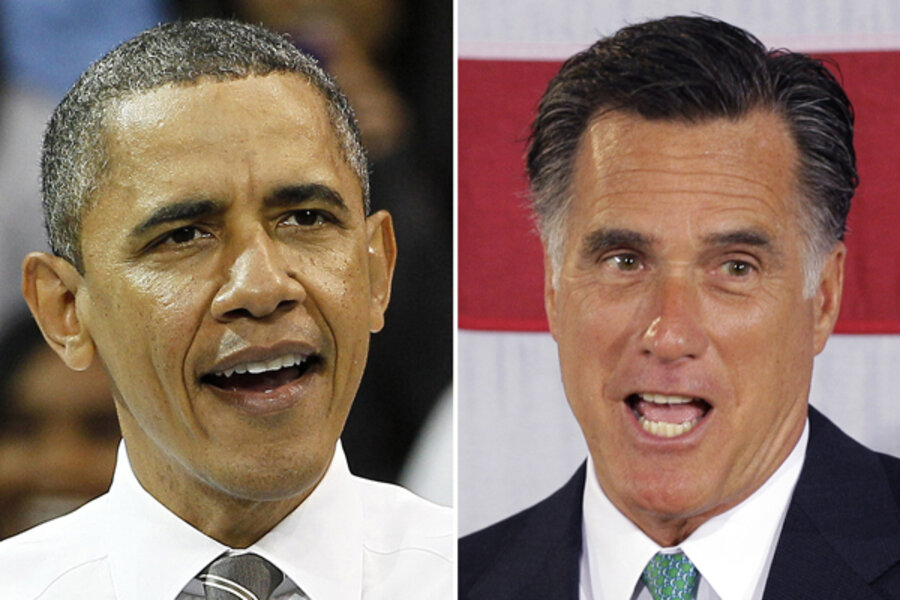Why is the Obama-Romney campaign rife with such awful ads?
Loading...
Why is the 2012 campaign so rife with awful ads?
It’s true that spots that clip or distort the truth have a long history in presidential runs, stretching back to Lyndon Johnson’s infamous “daisy" spot, which implied that electing Barry Goldwater would lead to nuclear war. But this time around, it seems, reporters are searching for new ways to say the word “slime.”
Exhibit A is the spot produced by Priorities USA Action, a pro-Obama "super PAC." It suggests that GST Steel employee Joe Soptic’s wife died of cancer because he lost his health insurance after Bain Capital, Mitt Romney’s firm, shuttered the plant. The ad has been furiously condemned by the Romney campaign and widely debunked by independent fact-checkers, who note among other things that Mr. Soptic’s wife had insurance through her own job and passed away years after GST’s bankruptcy.
Exhibit B is the Romney campaign’s ad suggesting that President Obama is doing away with work requirements for welfare – an assertion that fact-checkers have also found to be highly misleading. In between has been an array of various spots from both candidates and their allies that take the opponent’s words out of context to the point where their meaning is flipped 180 degrees.
One reason for Mudfest 2012 is the nature of an incumbent president’s run for reelection. Simply put, most incumbents win. As Seth Masket, associate professor of political science at the University of Denver, noted Thursday on the Mischiefs of Faction blog, of the 19 presidents who have run for another term since 1900, only four have lost.
“There’s a built in bias toward incumbents. Things have to be going pretty badly for one to be kicked out of office,” Mr. Masket wrote.
Why does this lead to ads that teeter on the edge of rationality? Because challengers push hard to depict the state of the nation as indeed awful – and because incumbents react by doing everything they can to make the election a referendum on their challenger. Particularly if, as is the current case, the economic state of the nation really isn’t very good.
Another reason for the political propensity to produce ooze is that most voters have already made up their minds. Gallup’s daily tracking poll, for instance, shows the 2012 undecided vote at between 6 and 8 percent, as opposed to about 11 percent at the same point in the last presidential election cycle.
That means much of the effort of the Obama and Romney efforts may be aimed not at winning over wavering voters, but at exciting supporters to make sure they go to the polls – and depressing opponents to the point where they stay home on Election Day because the political state of the nation is too awful to contemplate.
Some Republicans insist that is the real point of the Priorities USA Action spot – to make white working-class voters, a demographic that generally supports Mr. Romney, so angry and confused that they don’t vote.
“You wonder how low the turnout will get with voters watching this depressing spectacle,” writes the pro-Romney Jennifer Rubin on her Right Turn blog in The Washington Post.
These reasons for the current muck of political ads have held true for past campaigns, however. What may be unique to 2012 is the communications context of the modern age. Supreme Court decisions have allowed outside groups to raise and spend political money like never before, making them key players in the presidential wars. While such groups as Priorities USA Action may be controlled by Obama loyalists and may have a sort of nudge, nudge, wink, wink relationship with the official campaign, they aren’t under a candidate's direct control.
This leads to a diffusion of decisionmaking about ads and perhaps a race to the bottom in tone. Super PACs, after all, are answerable only to their donors – not to the US electorate per se.
The media are vastly different as well, with the Twitter-driven news cycle reducing time for contemplation and research, and partisan bloggers and news outlets redefining what constitutes mainstream reportage. The result: a world in which voters’ choices for information are more diverse than ever – and also a world in which a lie can travel halfway around the blogosphere before the truth gets on its polished wingtips.






